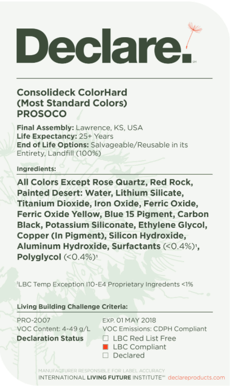updated March 25, 2019
Customers are driving businesses to report on the materials and chemicals used in their products. What information do you need, to demonstrate that your product line is preferable? How do you document the chemicals in your products in a clear way that customers can understand?
The mindset. First, set your company up to succeed on your product transparency mission. Embrace the ability to be more open about your products’ impacts both within your organization and with your customers. You will be opening up to learning more about your products and while you may not like your initial findings, you’ll have a tremendous opportunity to change materials to more sustainable ones.
Customers love truly authentic brands so connect by being both honest about where your chemicals management is today and aspirational about how you’re going to improve it. Customers want to hear about your journey!
The information. Most people are used to comparing nutrition labels on food items. They can readily see which ingredients were used, as well as specific information based on serving size. For consumer goods, consumers want to know where an item was made, how long it’s expected to last, and what potentially harmful ingredients are in it. In the building product industry, many different labels exist to demonstrate this information (e.g. Declare Labels, HPDs, LEED documentation). There is no systematic single transparency label used in any industry at the moment. However, there is an opportunity to be a first mover in your industry. Remember that customers want to see that you have the information to design better products, even if they don’t analyze every label or disclosure.
Your suppliers. Work with your supply chain to understand the materials used to make your product(s). If your suppliers don’t want to include proprietary information, that’s fine, as long as they identify chemical hazards so you can take them into account with your design and disclosures.
Align all of your products’ chemicals with matching hazard data from reliable sources including CA Prop 65, US EPA, US NIH and many others across the globe. Identify any that are flagged for concern and look for similar alternatives that are more sustainable. It reduces the risk for your company to be using safer alternatives, and your customers will be grateful to purchase products that are healthier for them and the environment.
The results. Report your results in a clear way. Using a standardized labeling system helps level the playing field. The Declare Label for building products was designed with this in mind. It takes into account environmental impacts and human toxicity including: the place where the product was manufactured, its life expectancy, disposal options, carbon footprint and the ingredients used to make the product. It provides customers with the information they want to make informed choices.
Be a leader. Become the first mover in your industry. Harvard University and other progressive institutions are adhering to the aggressive Living Building Challenge to design new facilities, which requires chemical disclosures, like the Declare Label, on all products. Many other organizations are meeting LEED (Leadership in Energy and Environmental Design) standards. The Declare Label is now accepted by LEED, making its use more widely recognized.
As for consumer goods, there are a variety of labels and restricted chemical lists to consider, including: Made Safe, Oeko-Tex, C2C banned chemicals list, US EPA Safer Chemicals List, EPEAT preferred chemicals, Green Good Housekeeping Seal, EWG SkinDeep, and others. Explore your options and choose what's right for your business.
Simplify the Process. Screen your products' substance lists against up-to-date regulatory lists. We created Toxnot Free so everyone can do this. We saw that creating Declare labels across a product portfolio had been time-consuming, with lots of manual calculations in excel and sending individual emails to suppliers. To simplify, Toxnot users may send supplier surveys so raw material data can be directly uploaded to your account and users can run checks for red-listed chemicals throughout their data collection process. Toxnot is now the platform to create and manage all Declare Labels. Not in the building industry? No problem; you can still screen for regulatory flags and create compliance reports for any product type.
Read Next:
Achieving Goals Through Supply Chain Engagement

